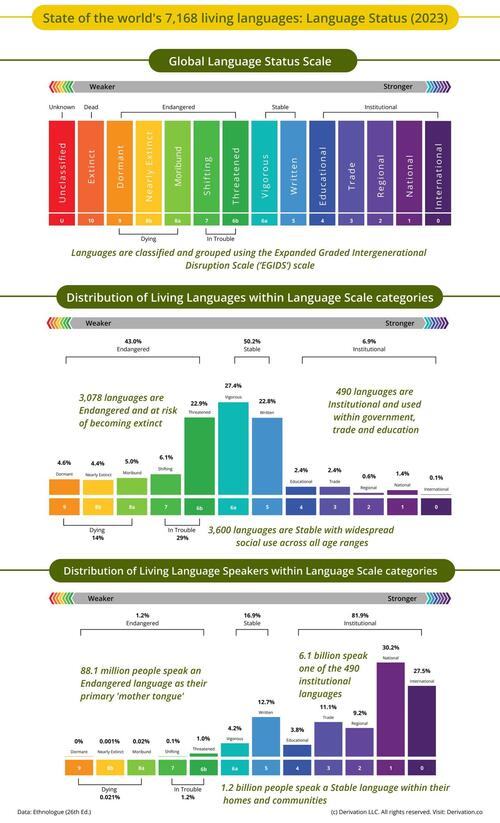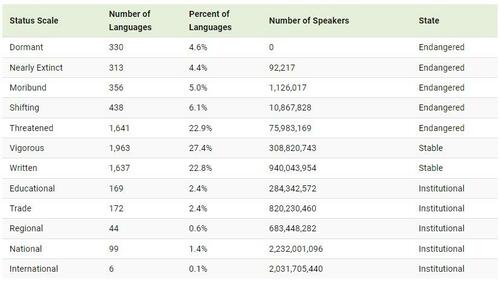The State Of The World’s 7,168 Languages
What are the roots of a living language, and how many are at risk of extinction?
This graphic via Visual Capitalist, from Stephen Jones, CEO of Derivation.co, shows the state of living languages around the world.
Mapping Out Living Languages
Across the 7,168 living languages today, 43% are at risk of being endangered.
In fact, a language dies off every 40 days. The vast majority of endangered languages are found in Indigenous communities, which risk the loss of culture and knowledge that they contain. At current rates, 90% of the world’s languages could disappear over the next 100 years.
According to data from Ethnologue, languages are classified across 12 states of vitality and three broader categories:
-
Endangered: Children do not learn and use the language, it is no longer the norm.
-
Stable: A language is used in the home and community, all children learn the language, but it is not formally used in institutions.
-
Institutional: A language is used beyond the community across institutions.
Today, over 88 million people speak endangered languages.
The region of Oceania has the largest density of endangered languages, with 733 at risk. With a population of 8.8 million, Papua New Guinea is home to the most languages in the world. Often, small linguistic communities will have only a couple hundred people speaking the language.
Africa has 428 that are endangered, many which are clustered around the equator. Displacement, drought, and conflict are some of the key reasons that languages risk being endangered.
In North and Central America, 222 languages are at risk of extinction. In fact, 98% of Indigenous languages in the U.S. are endangered, one of the highest rates in the world.
On the other end of the spectrum, there are 490 institutional languages with 6.1 billion speakers worldwide.
Revitalizing Languages
Thanks to key initiatives, languages can be preserved.
For instance, during the 1970s, the Māori language was spoken by just 5% of Māori schoolchildren. Fast forward to today, and 25% speak the language, driven by efforts from the Māori, leading the government to protect it by law.
In Hawaii, just 2,000 people spoke the native language in the 1970s. After the government ensured it was taught in schools, the number of speakers jumped to 18,700 in 2023.
Advancements in AI are also providing tools to preserve languages. Google and Microsoft, for instance, are developing AI tools that can translate languages at impressive speeds, allowing for dying languages to become more accessible so they are not erased.
Tyler Durden
Wed, 01/31/2024 – 04:15 Source
Related posts:
Views: 0
 RSS Feed
RSS Feed

















 January 31st, 2024
January 31st, 2024  Awake Goy
Awake Goy 






 Posted in
Posted in  Tags:
Tags: 
















